Bulletin – December 1997 Privatisation in Australia
- Download 57KB
In the 1990s, Australian Governments, both Commonwealth and State, have privatised a significant portion of the public sector.[1] This note provides information about privatisation of public trading enterprises (PTEs) in Australia, provides some international perspective and discusses the impact of privatisation on government finances and domestic financial markets.
The main points are:
- There has been an increasing amount of privatisation in Australia as the 1990s have progressed (Graph 1). While this trend is also evident overseas, Australia has had one of the larger programs among OECD countries – second, by value, to the UK and, relative to GDP, to New Zealand.
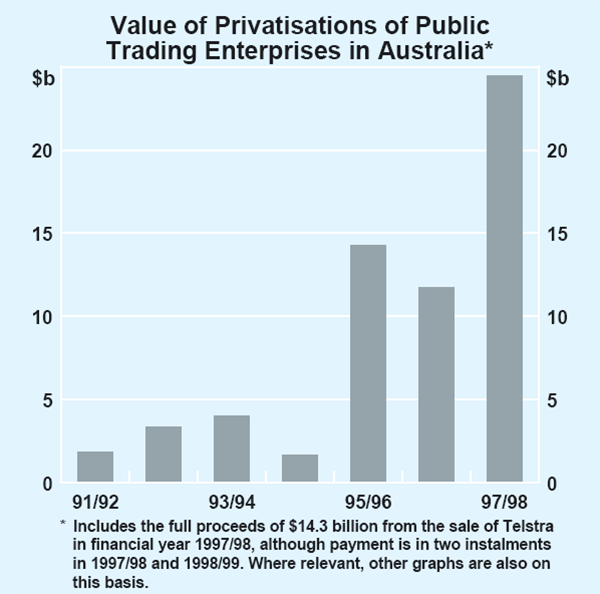
- Privatisation proceeds are estimated to have been about $61 billion in the 1990s so far, coming roughly equally from privatisations by State and Commonwealth Governments. Privatisation has occurred in three main sectors – financial services, electricity and gas, and transport and communication.
- Governments have sold assets both by offering equity to the public and through trade sales.
- Proceeds of sales have been used largely to reduce government debt, with a resulting fall in the value of government bonds outstanding.
- Privatisation has contributed to spreading direct ownership of shares more widely.
A list of privatisations in Australia is in the Appendix. Although not in any sense dealing with privatisation as such, the last section of the article has some remarks about the private financing of infrastructure projects, which may in the past have been undertaken by Governments in Australia.
International Perspective
Prior to the 1990s, there were only a few large privatisation programs in place. The most notable and earliest was in the UK in the early 1980s. Nearly all PTEs (about 50 in total) operating in the competitive sector of that economy were privatised. At later stages, public utilities, such as suppliers of water, were also privatised. A large number of countries have since followed the UK lead. According to the OECD, global privatisations totalled about US$30 billion in 1990 and are expected to reach nearly US$100 billion in 1997.
In recent years, Australia has had one of the largest programs of privatisation among OECD countries (Graph 2). The value of privatisations in Australia during the 1990s ranks second after the UK; it also ranks second, after New Zealand, relative to GDP.
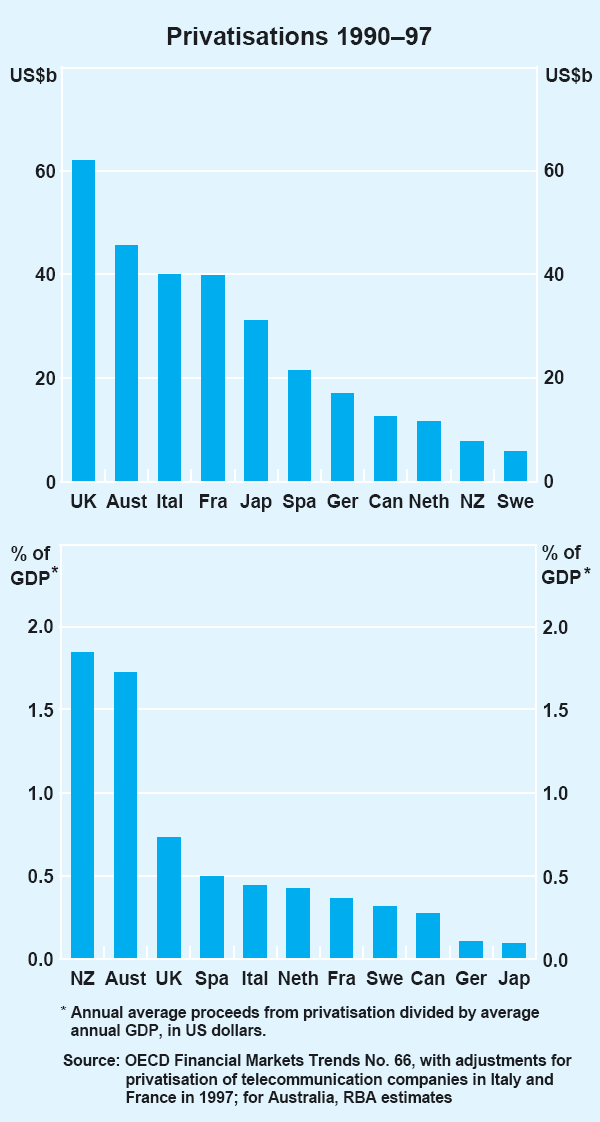
Privatisation in Australia
Privatisation in Australia started in earnest with the sale of the first tranche of the Commonwealth Bank in 1991,[2] an enterprise already operating in a commercial environment. One factor supporting its privatisation was the newly introduced capital adequacy guidelines for the banking industry. These meant that expansion by the bank would require increases in its equity base, which in turn would probably involve continuing calls on the Commonwealth budget. For many other PTEs, privatisation came after they had passed through a phase of corporatisation, whereby they were maintained under public ownership, but were required to achieve certain commercial benchmarks, pay tax, borrow funds without a government guarantee and have any regulatory advantages removed.[3]
PTEs have been sold at both the State and Federal levels of Government in Australia (Graph 3). After incorporating the proceeds from the partial sale of Telstra (including the second instalment due in November 1998), sales since 1990 of companies owned by the Commonwealth amount to about $30 billion. The Bank estimates that the sale of companies owned by State Governments in Australia is of similar magnitude, at $31 billion.
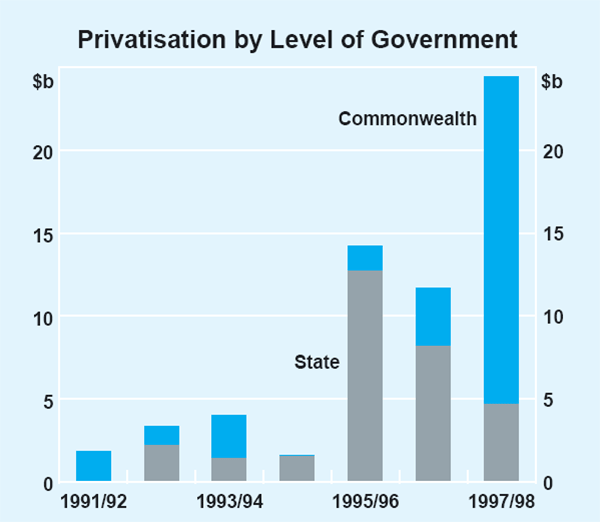
In Australia, privatisation has occurred principally among enterprises providing traditional public services such as transport, communications, electricity, and some publicly owned providers of financial services (Graph 4). For the Commonwealth, sales of transport and communications enterprises were most significant. The States initially privatised their banks and insurance offices, and this was followed in a number of States by sales of electricity and gas utilities. Some States have also sold their gambling interests. The Australian experience is consistent with the typical pattern observed in other OECD countries, where companies already operating in competitive sectors of the economy, such as financial institutions, were sold first. Those companies needing to restructure to make them commercially attractive, or which require a suitable regulatory framework (such as telecommunications and public utilities) usually appear later in the process.
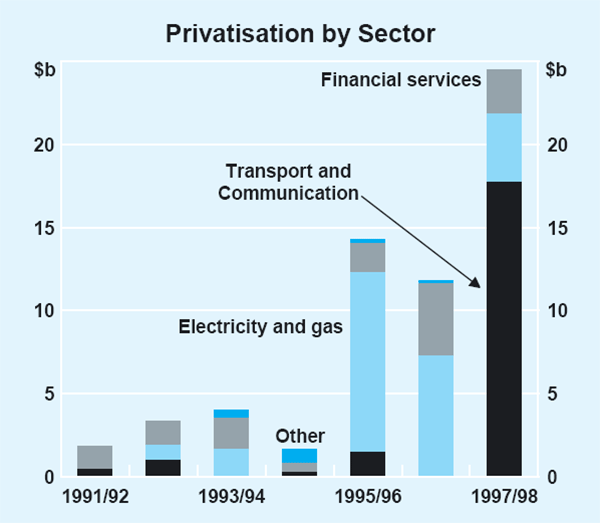
The progressive sale of the Commonwealth Bank, with proceeds in three tranches totalling $8.1 billion, was the largest finance sector privatisation. Three State banks have been sold and six States have privatised insurance companies.[4] Asset sales in the transport and communications sector have been dominated by transport-related sales, with the part-privatisation of Qantas in 1992/93, the remainder of Qantas in 1995/96 and sale of airports in Melbourne, Brisbane and Perth in 1997/98; in railways, the business units of Australian National (except interstate track) were privatised in mid 1997. In 1995/96 and 1996/97, privatisation was dominated by sales of Victorian electricity generators and distributors. These have also contributed to proceeds in 1997/98, although the part-sale of Telstra is expected to make the largest contribution this year.
| Year | Proceeds ($b) | |
|---|---|---|
| Electricity (Victoria) | 1992, 1995, 1996, 1997 | 22.5(a) |
| Telstra | 1997, 1998 | 14.3 |
| Commonwealth Bank | 1991, 1993, 1996, 1997 | 8.1 |
| Airports | 1997 | 3.3 |
| State insurance offices | 1992, 1993, 1994, 1995, 1996, 1997(b) | 3.1 |
| State banks (NSW, WA, SA) | 1994, 1995 | 2.2 |
| Qantas | 1993, 1995 | 2.1 |
|
(a) Includes cash proceeds at the time of sale but does not include additional monies
from licensing and franchise fees (with the exception of Loy Yang B). (b) The merger of Suncorp and QIDC with Metway is treated as privatisation of an insurance office. |
||
Method of Sale
There have been essentially two approaches to privatising PTEs in Australia:
- trade sales to another enterprise, often foreign and in the same line of business; and/or
- the public issue of equity.[5]
Since 1990, the Bank estimates that trade sales have raised around $34 billion, while public floats have raised around $27 billion (Graph 5).
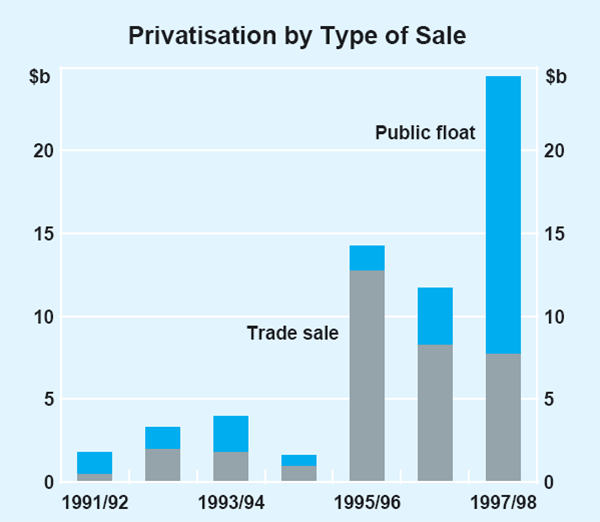
Trade sales, which usually involve a tendering process, might be expected to fetch a higher price as the purchaser acquires control of the enterprise. Also, the purchaser typically has expertise in managing similar businesses in other markets, and can bring this experience to bear in reshaping the management of the enterprise. This can accelerate the process of raising productivity and profitability compared with a public share issue. The Victorian electricity companies were sold by trade sales, largely to overseas power companies. The Bank estimates that foreign interests have been successful in a little over half (by value) of all trade sales.
Public floats have been a combination of sales to individuals as well as to institutional investors, both domestic and foreign. The Telstra float, by far the largest of its kind in Australia, took this form. Some assets have been sold as a combination of public offers and trade sales. For example, a stake of 25 per cent in Qantas was sold to British Airways, with the remainder offered, at a later date, for public subscription.
Financial Market Effects
Financial markets in Australia have coped well with the large program of privatisation in the 1990s. This is not surprising as, in large part, Governments have used the proceeds to retire, or contain a rise in, debt. On the one hand, privatisation has resulted in lower government debt and borrowing needs, while on the other, it has led to a rise in the supply of equity or a higher level of private borrowing. The ability of capital markets to manage this process has been helped by a rising share market, and by the strong growth of funds under management. The globalisation of financial markets has also helped, with many overseas institutional investors attracted to public floats in Australia, while foreign banks have participated in syndicated loans to finance trade sales of PTEs.
The proceeds of privatisation have contained the rise in official debt of some governments and have been used to retire debt of others. Apart from about $1 billion of proceeds from the sale of Telstra which has been earmarked to establish a fund to finance environmental initiatives, the Commonwealth plans to apply the proceeds from this float to retire debt. The Victorian Government recently indicated that future proceeds from privatisation may be used to finance unfunded superannuation liabilities, since debt reductions in Victoria to date have already resulted in an upgrading of the State's credit rating.
The impact of privatisation on debt levels has been particularly pronounced among State Governments; among the States, net debt has fallen from a peak of around $76 billion at June 1993 to $47 billion at June this year (Graph 6). Over the same period, domestic debt securities on issue from State Governments have declined by about one third to $38 billion. The decline in domestic debt outstanding has been evident in the issue of both long-term and short-term securities. Reduced outstandings in the market have flowed through fairly directly to trading activity, with turnover of State Government benchmark bonds falling by about 40 per cent since 1995. The reduction in debt on issue of State Governments has been assisted by their budgetary position having been kept close to balance in recent years.
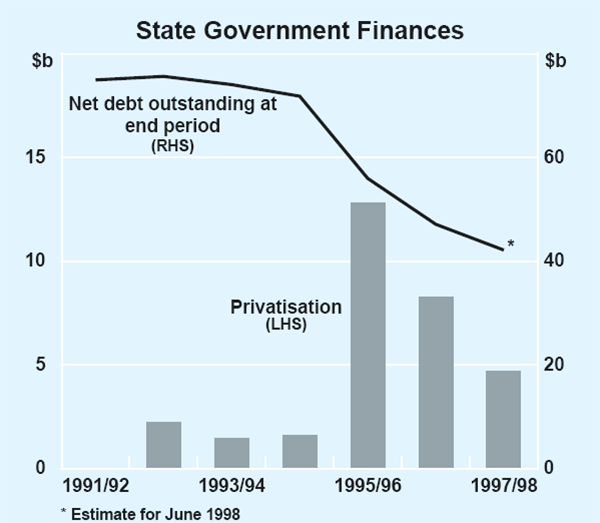
For the Commonwealth Government, proceeds from privatisation have helped contain growth in net debt in recent years (Graph 7). In 1997/98 and 1998/99, proceeds from the sale of Telstra and other assets are likely to lead to a substantial fall both in net debt and government borrowing. (The proceeds from the Telstra float will be received in instalments over 1997/98 and 1998/99). The stock of Commonwealth Government securities has steadied in the past year at around $110 billion, and is estimated by the Commonwealth Government to fall to around $105 billion by end June 1998 and to around $85 billion by 2000/2001, partly due to receipts from privatisations and partly due to the projected run of underlying budget surpluses.
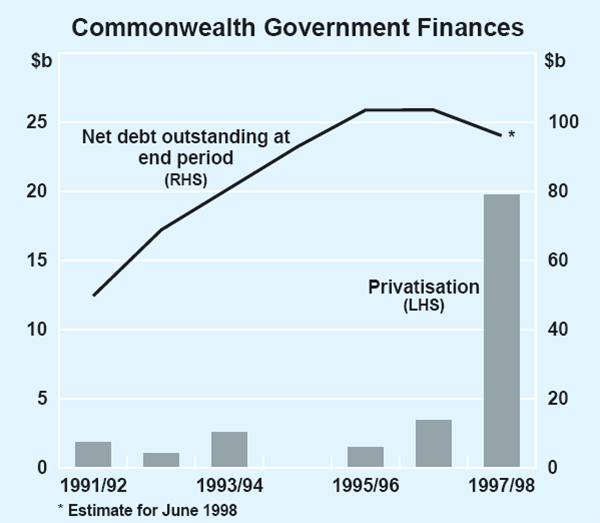
Private-sector financing of privatised assets has come from three sources – equity issues, borrowing from domestic and offshore banks and the issue of debt securities. Little reliable data are available on these sources of financing. However, a starting point for the estimation of the magnitudes involved are the data on how assets have been sold (Graph 5). About 45 per cent of privatisations have been share floats, directly affecting the equity market (see below). The remainder has been trade sales and their financing has usually involved syndicated loans from banks,[6] an equity contribution from the purchaser and the issuance of debt securities. While aggregate information on the financing mix for these privatisations is unavailable, some pointers can be obtained from Victorian electricity industry privatisations which have amounted to $22.5 billion. Borrowing from banks (mainly domestic) is estimated to have accounted for 65 per cent of the private-sector financing of these sales. The bulk of the remaining 35 per cent was equity provided by the purchasers, with less than 10 per cent raised through the issue of securities. While financing for the recent trade sale of the airports in Brisbane, Melbourne and Perth is still being put in place, syndicated loans account for about 65 per cent of the agreed funding to date.
The equity market has been a major beneficiary of privatisation, which has boosted both market capitalisation and liquidity. Former PTEs now listed on the stock exchange currently account for about 10 per cent of the capitalisation of the Australian share market, with the Telstra float contributing around 4 percentage points of this. Privatisations have also contributed to a large rise in the number of individuals directly holding shares; the proportion of adults directly owning shares has risen from 10 per cent in 1991 to more than 20 per cent according to a survey in early 1997 (Graph 8). (Many more individuals, of course, hold shares indirectly through assets held in insurance and superannuation funds.) The float of the Commonwealth Bank, for example, had a significant impact on individual share ownership between 1991 and 1994. The Commonwealth Bank had the largest register of any listed company, with 210,000 shareholders when first floated in 1991. This increased to 420,000 with the third sell-down in 1996. Telstra now has the largest number of shareholders in Australia, at 1.9 million. This is estimated to have increased the proportion of adults directly holding shares to around 25 per cent.
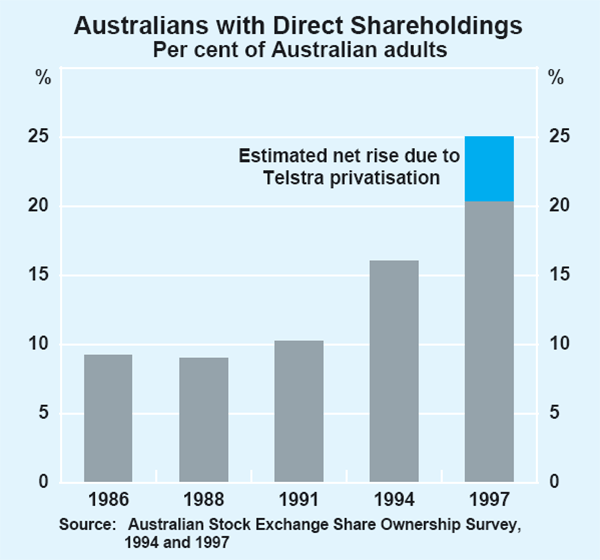
This discussion has focused only on the financing of the initial transactions. Clearly, there are second round effects on financial markets from funding the purchase of privatised assets. For example, share purchases by individuals may be funded by loans from banks.
Private Financing of Infrastructure
Infrastructure development traditionally has been undertaken by governments in Australia. With the trend to privatisation during the 1990s, however, the private financing and operation of infrastructure projects has been a natural progression. In many such projects, the ownership and operation of assets will eventually revert to public hands after an agreed period when it is expected that private investors will have recouped their initial outlay and made a profit on their capital.
The Commonwealth Government has provided tax concessions to assist private sector involvement in infrastructure, such as the Develop Australia Bond (DAB) scheme introduced in 1992. This scheme involved the transfer of tax benefits from project proponents to project financiers. In return for giving up these benefits, project proponents received lower interest rates on borrowings from financiers of the project.
Issues of infrastructure bonds under the DAB scheme were limited before May 1994, when several changes were made to enhance their appeal. This resulted in an upsurge of proposals and the scheme was frozen in late 1996 and ended in 1997 due to its cost to the Budget. Before the scheme was ended, 13 projects worth around $4.5 billion were approved, involving the issue of around $2.8 billion in infrastructure bonds. The approved projects cover a broad range of activities, including three major motorways in Sydney and Melbourne. The DAB scheme was replaced in 1997 with a tax rebate scheme.
State Governments have also joined forces with the private sector in the financing, construction and operation of infrastructure projects, especially in the provision of roads.
Appendix
|
Proceeds $ million |
Type of Sale |
Financial Year of Privatisation |
|
|---|---|---|---|
| Commonwealth Government | |||
| Aerospace Technologies of Australia | 40 | trade sale | 94/95 |
| Australian Industry Development Corporation | 25 | public float | 89/90 |
| Australian Industry Development Corporation | 200 | trade sale | 97/98 |
| AUSSAT | 504 | trade sale | 91/92 |
| Australian Airlines | 400 | trade sale | 92/93 |
| Australian National (rail) | 95 | trade sale | 97/98 |
| Avalon Airport Geelong | 1.5 | trade sale | 96/97 |
| Brisbane Airport | 1,387 | trade sale | 97/98 |
| Commonwealth Serum Laboratories | 299 | public float | 93/94 |
| Commonwealth Bank(b) | 1,311 | public float | 91/92 |
| Commonwealth Bank | 1,686 | public float | 93/94 |
| Commonwealth Bank | 3,390 | public float | 96/97 |
| Commonwealth Bank | 1,770 | public float | 97/98 |
| Commonwealth Funds Management | 63 | trade sale | 96/97 |
| Melbourne Airport | 1,307 | trade sale | 97/98 |
| Moomba-Sydney Pipeline | 534 | trade sale | 93/94 |
| Perth Airport | 643 | trade sale | 97/98 |
| Qantas | 665 | trade sale | 92/93 |
| Qantas | 1,450 | public float | 95/96 |
| Snowy Mountains Engineering Corporation(c) | 1 | trade sale | 93/94 |
| Snowy Mountains Engineering Corporation(c) | 0.3 | trade sale | 94/95 |
| Snowy Mountains Engineering Corporation(c) | 0.3 | trade sale | 95/96 |
| Telstra | 14,330 | public float | 97/98 |
| Total Commonwealth | 30,102 | ||
| State Governments | |||
| New South Wales | |||
| Axiom Funds Management | 240 | trade sale | 96/97 |
| Government Insurance Office | 1,260 | public float | 92/93 |
| NSW Grain Corporation | 96 | trade sale | 93/94 |
| NSW Investment Corporation | 60 | trade sale | 89/90 |
| State Bank of NSW | 527 | trade sale | 94/95 |
| Total New South Wales | 2,183 | ||
| Victoria | |||
| Electricity Industry: | |||
| Citipower | 1,575 | trade sale | 95/96 |
| Eastern Energy | 2,080 | trade sale | 95/96 |
| Hazelwood/Energy Brix | 2,400 | trade sale | 96/97 |
| Loy Yang A | 4,746 | trade sale | 96/97 |
| Loy Yang B | 544 | trade sale | 92/93 |
| Loy Yang B(d) | 1,150 | trade sale | 97/98 |
| Powercor | 2,150 | trade sale | 95/96 |
| PowerNet | 2,555 | trade sale | 97/98 |
| Solaris | 950 | trade sale | 95/96 |
| Southern Hydro | 391 | trade sale | 97/98 |
| United Energy | 1,553 | trade sale | 95/96 |
| Yallourn Energy | 2,428 | trade sale | 95/96 |
| Other: | |||
| BASS (Ticket sales) | 3 | trade sale | 94/95 |
| GFE (Gas & Fuel Exploration) Resources | 56 | trade sale | 95/96 |
| Grain Elevators Board | 52 | trade sale | 94/95 |
| Heatane Division of Gas & Fuel Corporation | 130 | trade sale | 92/93 |
| Port of Geelong | 51 | trade sale | 95/96 |
| Port of Portland | 30 | trade sale | 95/96 |
| Portland Smelter Unit Trust | 171 | trade sale | 92/93 |
| State Insurance Office | 125 | trade sale | 92/93 |
| TABCORP | 609 | public float | 94/95 |
| Total Victoria | 23,749 | ||
| Queensland | |||
| Gladstone Power Station | 750 | trade sale | 93/94 |
| State Gas Pipeline | 163 | trade sale | 96/97 |
| Suncorp/Qld Industry Development Corp(e) | 698 | trade sale | 96/97 |
| Suncorp-Metway Ltd(e) | 610 | public float | 97/98 |
| Total Queensland | 2,220 | ||
| South Australia | |||
| Austrust Trustees | 44 | trade sale | 94/95 |
| Enterprise Investments | 38 | trade sale | 94/95 |
| Forwood Products (Timber) | 123 | trade sale | 95/96 |
| Island Seaway | 2 | trade sale | 94/95 |
| Pipeline Authority of SA | 304 | trade sale | 94/95 |
| Port Bulk Handling Facilities | 18 | trade sale | 97/98 |
| Radio 5AA | 8 | trade sale | 96/97 |
| SA Financing Trust | 5 | trade sale | 93/94 |
| SAGASCO | 29 | trade sale | 92/93 |
| SAGASCO | 417 | trade sale | 93/94 |
| SAMCOR (meatworks) | 5 | trade sale | 96/97 |
| Sign Services | 0.2 | trade sale | 95/96 |
| State Government Insurance Commission | 175 | trade sale | 95/96 |
| State Bank of SA | 10 | trade sale | 94/95 |
| State Bank of SA | 720 | trade sale | 95/96 |
| State Chemistry Laboratories | 0.3 | trade sale | 95/96 |
| State Clothing Corporation | 1.4 | trade sale | 95/96 |
| Total South Australia | 1,899 | ||
| Western Australia | |||
| BankWest | 900 | trade sale | 95/96 |
| Healthcare Linen | 9 | trade sale | 96/97 |
| State Government Insurance Office | 165 | public float | 93/94 |
| Total Western Australia | 1,074 | ||
| Tasmania | |||
| State Insurance Office | 42 | trade sale | 93/94 |
| Total Tasmania | 42 | ||
| Total State Governments | 31,166 | ||
| Total All Governments | 61,269 | ||
| memo items: | |||
| Total trade sales | 34,364 | ||
| Total public floats | 26,905 | ||
|
(a) Privatisation is defined here as the sale of public trading enterprises and does
not include asset sales such as of buildings or plant and equipment.
(b) The sale of the first tranche of the Commonwealth Bank was an initial public offering by the Commonwealth Bank to raise capital. The proceeds of $1.3 billion were received by the Commonwealth Bank to part fund the purchase of State Bank of Victoria, from the Victorian Government for a total of $1.6 billion. The sale of the State Bank of Victoria to the Commonwealth Bank is not included above in the list of privatisations of the Victorian Government. (c) Management buyout. (d) Includes franchise, licence fees etc. (e) Suncorp and the Queensland Industry Development Corporation were wholly owned by the Queensland Government. These businesses were merged with Metway Bank Limited on 1 December 1996. Consideration received by the Queensland Government for contributing these businesses to the merger comprised $698 million and 142.8 million shares in Metway Bank Limited. Subsequently the Government sold down part of its shareholding for $610 million, to be received in two instalments in 1997/98 and 1998/99. |
|||
Footnotes
Privatisation is the full or partial transfer of ownership of public assets to the private sector. This process refers to the sale of enterprises which are a ‘going concern’ rather than the sale of land or buildings. Privatisation does not cover activities such as contracting out, leasing and private financing of infrastructure projects. The data on the scale and composition of privatisation in Australia came from a number of separate publicly available sources, including press reports and publications of Commonwealth and State treasury departments. [1]
The Commonwealth Government started a program of asset sales in 1987 and by 1991 had disposed of about $2 billion in assets, nearly all property rather than PTEs. [2]
In 1995, the Council of Australian Governments agreed to apply the principle of competitive neutrality to the operation of all PTEs – essentially meaning that PTEs would be required to operate on a fully commercial basis. The relevant agreement itself was neutral in relation to the form of ownership of PTEs, and was not intended to promote either public or private ownership. [3]
The State Bank of Victoria was sold to the Commonwealth Bank in 1991/92, and is not included as a privatisation. The Commonwealth Bank's first share issue in 1991 was for the purpose of raising funds to make this acquisition. [4]
Exceptions were the privatisation of Snowy Mountains Engineering Corporation, which was through a management buyout, and the merger of Suncorp and QIDC with Metway. [5]
The size of the loan involved in the purchase of a PTE is often beyond the funding and risk capacity of a single bank, so that syndicated loans are common. A syndicated loan is arranged by one or more banks with the funds coming from a number of other banks. Foreign banks have participated in these syndications. [6]